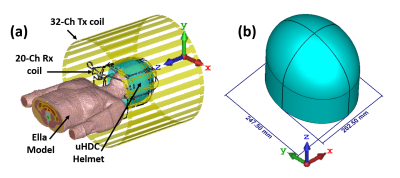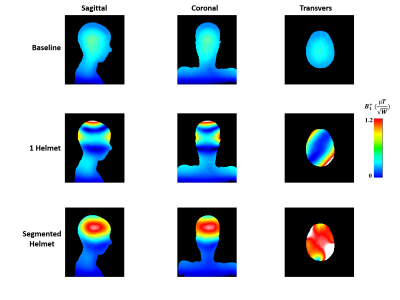4081
The manipulation of displacement current wave in ultra-High Dielectric Constant Helmet on B1 field distribution in human head at 3T1Department of Neurosurgery, PennState University College of Medicine, Hershey, PA, United States, 2Department of Radiology, PennState University College of Medicine, Hershey, PA, United States, 3HyQ research Solution, State College, PA, United States, 4Department of Engineering Science and Mechanics, Pennsylvania State University, State College, PA, United States
Synopsis
A displacement current wave is formed in an ultra-high dielectric constant (uHDC) helmet, which perturbs transmission B1 field uniformity within the human head as a result of phase retardation. With computer modeling, we manipulated the displacement current by segmenting the helmet into multiple pieces to control the propagation of the induced displacement current wave to “shim” the B1 field inside a human head model. We demonstrated that with a 4-segmented helmet, we can obtain a uniform B1+ distribution within the human brain with enhanced transmit efficiency.
Introduction
We previously demonstrated employing ultra-high dielectric constant (uHDC) materials can enhance transmit efficiency of an RF coil as well as signal to noise ratio (SNR) by inducing the displacement current in uHDC material 1, 2. Enhancement of the brain cortex SNR requires a solution that encloses the head with uHDC material in a helmet-type design. Our previous attempt using a conformal prototype uHDC helmet with high permittivity (εr ~ 1000) has demonstrated a displacement current “wave” that propagating over the helmet, which disrupted the uniformity of the transmission field significantly 3. In this work we investigate manipulation of the displacement current distribution by segmenting helmet into 4 Pieces to enhance the field uniformity.Methods
Simulation: is performed in CST microwave studio as a full wave simulation software at 3T proton imaging (125 MHz).Setup: includes the two 16-rung Tx birdcage (BC) coil excited with 90 degree phase difference, and 16/4 channel Rx head/neck coil (Fig.1a). The Ella human brain model 4 is used for the simulation. The diameter/length of the BC coil is 50 cm/60 cm. The Rx neck elements were not working for calculating the receive sensitivity.
Transmit efficiency/SNR: The transmit efficiency is calculated by dividing the calculated B1+ over the square root of the total dissipated power within the brain. The scaled SNR is calculated by diving the B1- over the noise level (from electric field co-variance matrix 5).
uHDC material: a helmet shaped structure is modeled from uHDC material with the permittivity of εr=1000 and the thickness of 8mm. As shown in Fig.1b the helmet is segmented into 4 parts along sagittal and coronal planes. There is a gap of 2mm between each segmentation. The longer and shorter diameter of the helmet is chosen to be 202.5 mm and 247.5 mm, respectively.
The displacement current: is calculated from the tangential electric field on the surface of the helmet based on (1) for both 1 piece helmet and the segmented helmet.
$$\overrightarrow{J}_{displacement}=j\omega\epsilon_0\epsilon_r\overrightarrow{E}\qquad\qquad\qquad\qquad\qquad\qquad (1)$$
Results and Discussion
Fig.2 shows the B1+ efficiency within the human head at sagittal, coronal and transverse slices for three configurations: 1) baseline (no HDC helmet), 2) 1 piece helmet and 3) 4-segmented HDC helmet. For 1-piece helmet, the B1+ is greatly enhanced but at a cost of homogeneity: a strong B1+ on the top of the head surrounded by a dark band extended from the frontal cortex to the back. Apparently, a strong RF field gradient was created by the highly concentrated displacement current on the top of the helmet (Fig. 3a). However, by segmenting the helmet into four equal pieces (Fig. 3b), the displacement current wave was constrained within the segmented pieces and no longer be able to propagate over the helmet. As a result, the dark band was removed and B1+ field uniformity in the brain was significantly improved (Fig. 2 bottom row). In addition, the overall transmit efficiency is increased by over 300%. The reason for the improvement of intensity and uniformity of transmit efficiency can be seen in Fig. 3. The displacement current distribution for 1-piece helmet is concentrated on the top of the helmet, however for segmented helmet the displacement current loops are guided to the side of the helmet (Fig.3b). The displacement current loop induced on each opposite segment at different phases are in sync with each other which, in return, synergistically enhance the B1 field. Fig.4 shows the scaled SNR for the three configurations. As can be seen we still have increased SNR value compared to the baseline. Since there are relatively small gaps (2mm) to the size of the Rx coil between each segment, we do not lose SNR compared to the 1 piece helmet.Conclusion
In this work we showed the enhanced the B1+ field distribution uniformity as well as the intensity inside the brain, by segmentation of an uHDC helmet into 4 pieces. We showed that the in-phase displacement current at opposite segments of the helmet not only enhanced the intensity of the B1 field uniformity but it also increased the B1 intensity in the brain. The SNR enhancement by the uHDC helmet compared to the baseline remained the same for the two configurations.Acknowledgements
No acknowledgement found.References
1. Yang, Q.X., et al., Radiofrequency field enhancement with high dielectric constant (HDC) pads in a receive array coil at 3.0T. J Magn Reson Imaging, 2013. 38(2): p. 435-40.
2. Rupprecht, S., et al., Improvements of transmit efficiency and receive sensitivity with ultrahigh dielectric constant (uHDC) ceramics at 1.5 T and 3 T. Magn Reson Med, 2018. 79(5): p. 2842-2851.
3. Sica, C.T., et al., Toward whole-cortex enhancement with a ultrahigh dielectric constant helmet at 3T. Magnetic Resonance in Medicine, 2019. 0(0).
4. Christ, A., et al., The Virtual Family—development of surface-based anatomical models of two adults and two children for dosimetric simulations. Physics in Medicine and Biology, 2010. 55(2): p. N23-N38.
5. Roemer, P.B., et al., The NMR phased array. Magnetic Resonance in Medicine, 1990. 16(2): p. 192-225.
Figures



